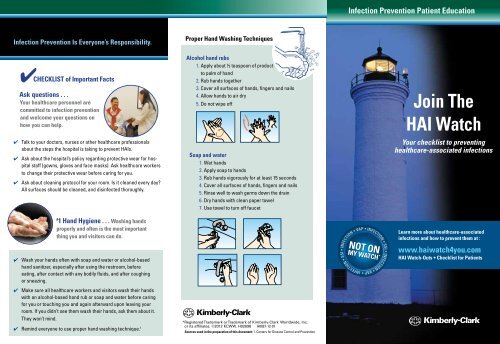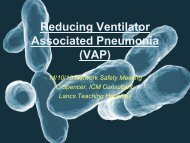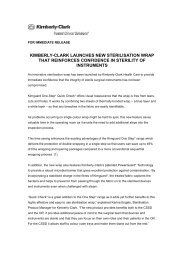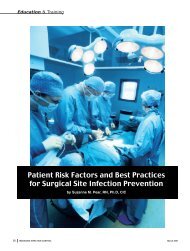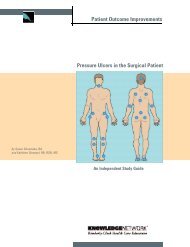HAI Watchouts Checklist for Patients
HAI Watchouts Checklist for Patients
HAI Watchouts Checklist for Patients
You also want an ePaper? Increase the reach of your titles
YUMPU automatically turns print PDFs into web optimized ePapers that Google loves.
Infection Prevention Patient Education<br />
Infection Prevention Is Everyone’s Responsibility.<br />
Proper Hand Washing Techniques<br />
4CHECKLIST of Important Facts<br />
Ask questions . . .<br />
Your healthcare personnel are<br />
committed to infection prevention<br />
and welcome your questions on<br />
how you can help.<br />
✔✔<br />
Talk to your doctors, nurses or other healthcare professionals<br />
about the steps the hospital is taking to prevent <strong>HAI</strong>s.<br />
✔✔<br />
Ask about the hospital’s policy regarding protective wear <strong>for</strong> hospital<br />
staff (gowns, gloves and face masks). Ask healthcare workers<br />
to change their protective wear be<strong>for</strong>e caring <strong>for</strong> you.<br />
✔✔<br />
Ask about cleaning protocol <strong>for</strong> your room. Is it cleaned every day<br />
All surfaces should be cleaned, and disinfected thoroughly.<br />
Alcohol hand rubs<br />
1. Apply about ½ teaspoon of product<br />
to palm of hand<br />
2. Rub hands together<br />
3. Cover all surfaces of hands, fingers and nails<br />
4. Allow hands to air dry<br />
5. Do not wipe off<br />
Soap and water<br />
1. Wet hands<br />
2. Apply soap to hands<br />
3. Rub hands vigorously <strong>for</strong> at least 15 seconds<br />
4. Cover all surfaces of hands, fingers and nails<br />
5. Rinse well to wash germs down the drain<br />
6. Dry hands with clean paper towel<br />
7. Use towel to turn off faucet<br />
Join The<br />
<strong>HAI</strong> Watch<br />
Your checklist to preventing<br />
healthcare-associated infections<br />
#<br />
1 Hand Hygiene . . . Washing hands<br />
properly and often is the most important<br />
thing you and visitors can do.<br />
✔✔<br />
Wash your hands often with soap and water or alcohol-based<br />
hand sanitizer, especially after using the restroom, be<strong>for</strong>e<br />
eating, after contact with any bodily fluids, and after coughing<br />
or sneezing.<br />
*<br />
Learn more about healthcare-associated<br />
infections and how to prevent them at :<br />
www.haiwatch4you.com<br />
<strong>HAI</strong> Watch-Outs • <strong>Checklist</strong> <strong>for</strong> <strong>Patients</strong><br />
✔✔<br />
Make sure all healthcare workers and visitors wash their hands<br />
with an alcohol-based hand rub or soap and water be<strong>for</strong>e caring<br />
<strong>for</strong> you or touching you and again afterward upon leaving your<br />
room. If you didn’t see them wash their hands, ask them about it.<br />
They won’t mind.<br />
✔✔<br />
Remind everyone to use proper hand washing technique. 1<br />
*Registered Trademark or Trademark of Kimberly-Clark Worldwide, Inc.<br />
or its affiliates. ©2012 KCWW. H02698 H0027-12-01<br />
Sources used in the preparation of this document: 1. Centers <strong>for</strong> Disease Control and Prevention.
Your <strong>Checklist</strong> to<br />
Preventing Healthcare-<br />
Associated Infections<br />
What is a healthcare-associated<br />
infection or <strong>HAI</strong> It’s a serious<br />
infection that develops in a patient<br />
48 hours or more after entering the<br />
hospital. As many as one of every<br />
20 patients may get an <strong>HAI</strong> while<br />
receiving treatment <strong>for</strong> other conditions.<br />
1 Learn how you can protect<br />
yourself or loved ones from healthcare-associated<br />
infections while in<br />
the hospital or healthcare facility.<br />
*<br />
4<br />
Your <strong>Checklist</strong> <strong>for</strong> <strong>HAI</strong> Prevention:<br />
If you are having surgery . . .<br />
to prevent a SSI (surgical site infection)<br />
✔✔<br />
If you smoke, stop – at least until you have recovered from surgery.<br />
✔✔<br />
Eat a good diet, avoid alcohol and get plenty of rest.<br />
✔✔<br />
Follow your surgeon’s instructions carefully be<strong>for</strong>e and after<br />
surgery, including bathing with antibacterial soap if instructed.<br />
✔✔<br />
Wash your hands with soap and water, or alcohol hand sanitizer<br />
be<strong>for</strong>e touching the incision or changing the dressing.<br />
If you have a urinary catheter . . .<br />
to prevent a UTI (urinary tract infection)<br />
✔✔<br />
Ask if the urinary catheter is absolutely necessary and how long<br />
will it be in place.<br />
✔✔<br />
Make sure your healthcare professional cleans hands properly<br />
be<strong>for</strong>e inserting the catheter and each time be<strong>for</strong>e touching it.<br />
✔✔<br />
Leave the tubing alone. Do not tug, pull, twist or kink the<br />
catheter tubing.<br />
✔✔<br />
Make sure the urine bag is placed below the level of the bladder<br />
to prevent back flow of urin from the bag.<br />
✔✔<br />
If you go home with a catheter, be sure to wash hands<br />
properly be<strong>for</strong>e and after touching it.<br />
If you are not on a ventilator . . .<br />
to prevent HAP (hospital-acquired pneumonia)<br />
✔✔<br />
Brush your teeth twice a day. Family members should ask your<br />
healthcare provider to help with these tasks if you are unable.<br />
✔✔<br />
Do breathing exercises as recommended by your<br />
healthcare provider.<br />
✔✔<br />
Get out of bed and walk as often as allowed.<br />
If your loved one is on a ventilator . . .<br />
to prevent HAP (hospital-acquired pneumonia)<br />
✔✔<br />
Make certain oral hygiene is per<strong>for</strong>med on the patient daily.<br />
✔✔<br />
Observe that healthcare providers wash their hands<br />
or use hand sanitizer be<strong>for</strong>e touching the patient.<br />
✔✔<br />
Do not manipulate the patient’s ventilator tube and keep<br />
patient’s bed at least a 30° angle as set by healthcare provider.<br />
If you have a central line . . .<br />
to prevent a CLABSI (central line-associated bloodstream<br />
infection)<br />
✔✔<br />
Make sure the person inserting the line has washed hands<br />
be<strong>for</strong>e beginning the procedure and wears sterile gloves,<br />
sterile gown, a cap and mask.<br />
✔✔<br />
Your skin should be cleaned with antiseptic and allowed<br />
to dry be<strong>for</strong>e the line is inserted.<br />
✔✔<br />
Your entire body should be covered including head and feet<br />
with a sterile drape.<br />
✔✔<br />
After the central line is placed, make sure anyone maintaining<br />
it washes hands properly be<strong>for</strong>e touching the line.<br />
✔✔<br />
Make certain anyone injecting anything into the central line<br />
scrubs the entry port vigorously <strong>for</strong> at least 15 seconds<br />
be<strong>for</strong>e the injection.<br />
✔✔<br />
Avoid touching the line; don’t get it wet. If the bandage<br />
becomes wet or dirty or comes off, tell your nurse or<br />
doctor right away.<br />
✔✔<br />
Ask when your central line can be removed.<br />
As you approach a hospitalization or medical procedure,<br />
we at Kimberly-Clark encourage you to take the time to learn more<br />
about healthcare-associated infection. The steps you take could<br />
help make the difference <strong>for</strong> your speedy recovery and return to<br />
health and wellness.<br />
Learn more about healthcare-associated infections and how to prevent them at:<br />
www.haiwatch4you.com<br />
(See hand washing tips on back.)


